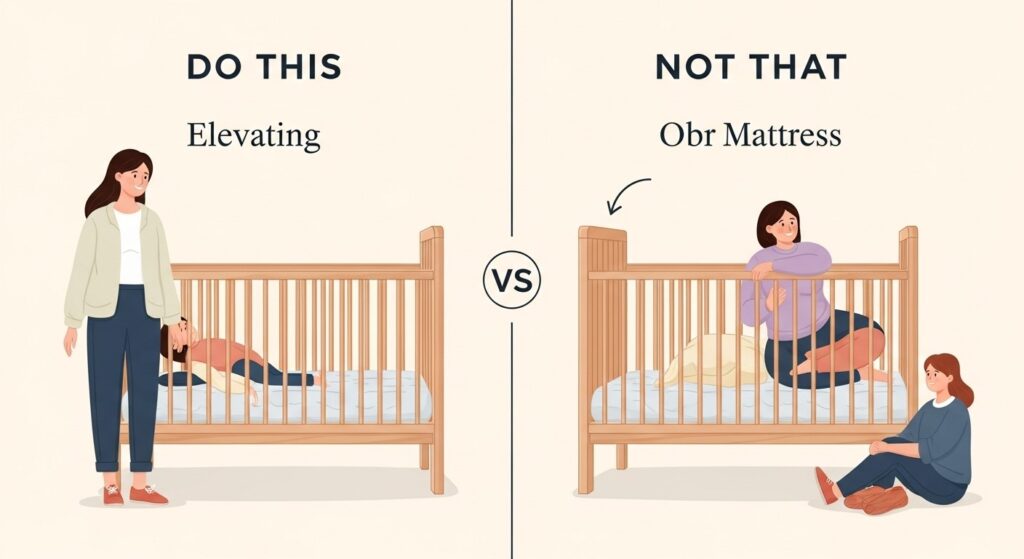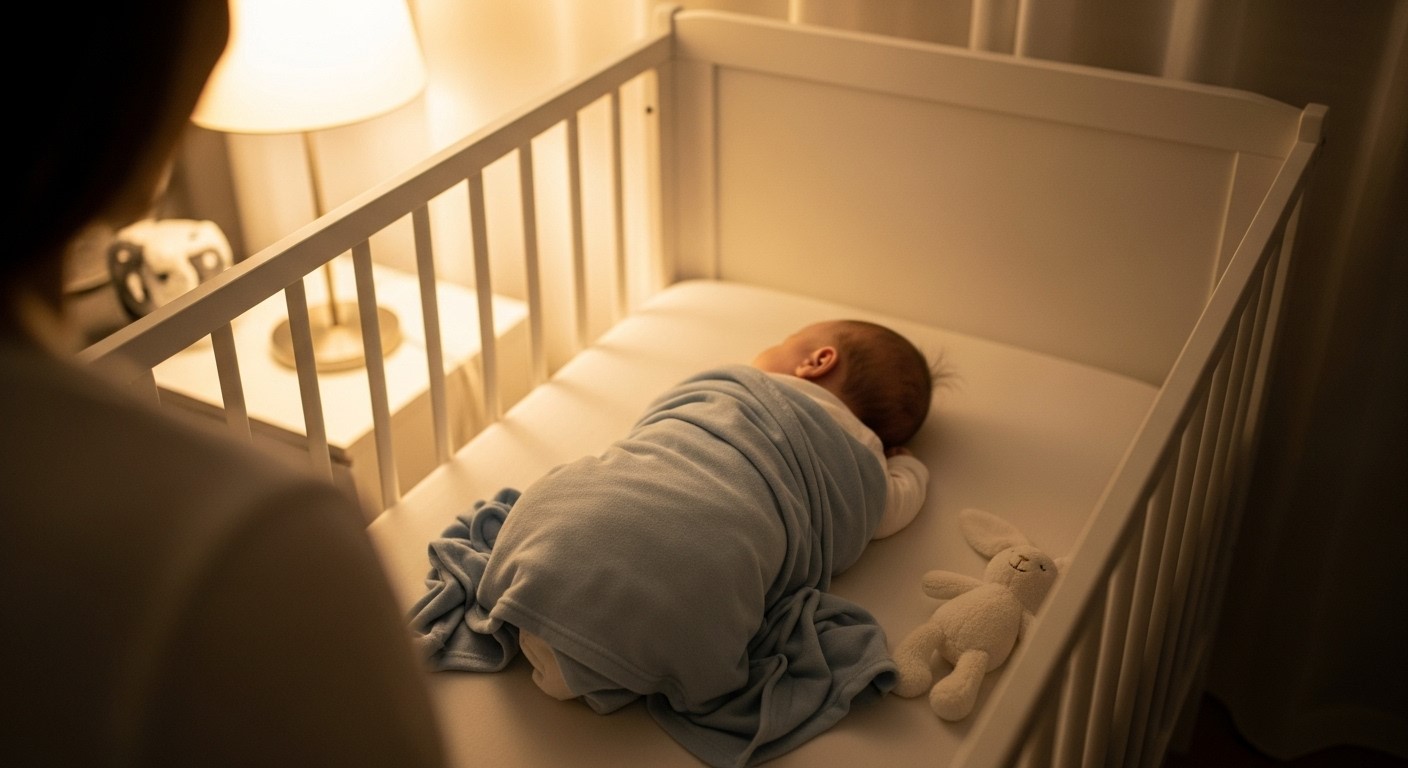How to Safely Elevate a Crib Mattress for a Sick Baby?: A Step-by-Step Guide for Worried Parents
There are few sounds more heartbreaking than your congested baby struggling to sleep.
You listen to every labored breath over the monitor, feeling helpless and exhausted.
All you want in the world is to provide them with some relief so they can rest comfortably.
You’re in the right place. In the middle of the night, searching for answers, you need clarity, not more confusion.
This guide will give you safe, clear, and actionable steps to help your baby breathe easier.
What makes this guide different? We don’t just list a few methods.
We explain the critical safety principles behind each step, backed by safe sleep guidelines for infants, to give you complete confidence in your choice.
We will help you navigate the “what-ifs” so you can make a safe decision for your family.
The Most Important Question: Is Elevating a Crib Mattress Actually Safe?
Before you touch a single thing in the crib, let’s address the fear in the room.
You’ve probably heard that any incline is dangerous. This is a valid and important concern.
What the American Academy of Pediatrics (AAP) Says About “Back to Sleep”
The AAP’s official safe sleep guidelines are the gold standard for infant safety.
They recommend that infants should always be placed on their back, on a flat, firm surface without any soft bedding, pillows, or bumpers.
This “Back to Sleep” campaign has been instrumental in reducing the rate of Sudden Infant Death Syndrome (SIDS).
Understanding the Real Risks: How Elevation Can Lead to Positional Asphyxiation
The primary danger of an incline is that a baby can slide down or roll into a position where their chin slumps to their chest.
This can obstruct their delicate airway, a dangerous condition known as positional asphyxiation.
This is also why you must never let a baby sleep in a car seat, swing, or bouncy seat outside of its intended use.
The “Risk vs. Benefit” Calculation
While a flat surface is always the default, some pediatricians may recommend a slight elevation for severe congestion or reflux.
The key is to do it in a way that minimizes the risk of sliding. Always consult your pediatrician before elevating your baby’s sleep surface.
The Safest Method: Using a Commercial Crib Wedge
If you and your doctor decide elevation is necessary, using a product designed for this purpose is often the safest bet.
What Is a Crib Wedge for Congestion and Why Is It Placed Under the Mattress?
A crib wedge is a firm, angled pad. Crucially, a safe wedge is designed to be placed underneath the crib mattress, not on top of it.
This creates a gentle, stable incline of the entire sleep surface without introducing a soft object into the crib.
How to Choose a Safe Wedge: Firmness, Size, and Certifications
- Firmness: The wedge should be very firm, not soft or memory-foam-like.
- Full Width: It should span the entire width of the crib to ensure the mattress doesn’t tilt or have gaps.
- Non-Skid Surface: A good wedge will have a non-skid bottom to prevent it from shifting under the mattress.
Step-by-Step Instructions for Correct Installation
- Remove the crib mattress.
- Place the wedge at the head of the crib, directly on the mattress support.
- Place the mattress back on top of the wedge.
- Press down firmly. Ensure the mattress is snug and there are no gaps between the mattress and the sides of the crib.

The DIY Approach: How to Elevate the Crib Legs Safely
If you don’t have a wedge, you can use household items to elevate the crib itself, but only if done with extreme caution.
A Crucial Warning: Why you should NEVER place items directly under the mattress.
So, is it safe to put a towel under the crib mattress? The answer is an emphatic no.
Placing towels, pillows, or blankets directly under the mattress creates a soft, uneven surface that can cause your baby to roll and increases the risk of suffocation.
The Right Way: Using Sturdy Books or Blocks
Instead of modifying the inside of the crib, elevate the two legs at the head of the crib.
- Find two identical, sturdy objects. Identical, thick books (like textbooks) or solid wood blocks are good options.
- Lift one leg at the head of the crib and securely place a block underneath it.
- Repeat on the other leg at the head of the crib.
- Crucially, ensure the blocks are the exact same height.
Checking for Stability
After elevating, grab the sides of the crib and shake it firmly. It should feel just as stable as it did on the floor.
If there is any wobbling or instability, this method is not safe for your crib.
Pro-Tips: Getting the Angle and Safety Checks Right
Drawing from expert analysis, a biomechanical study on infant sleep safety concluded that an incline of 10 degrees is likely safe and does not significantly impact a baby’s muscle activity or positioning.
However, at a 20-degree incline, there is a risk of muscle fatigue, and at 30 degrees, infants can no longer maintain a lying posture and begin to slide.
Therefore, as one pediatric specialist with a PhD in infant development advises, if you elevate the sleep surface, the incline should be no more than 7-10 degrees.
This reinforces the critical advice for parents: “Parents often think more is better, but a subtle incline is both safer and more effective.
Your goal is to offer gentle relief, not to prop the baby up.”
What is the best angle to elevate a crib mattress?
Less is more. A gentle incline of just 10 to 15 degrees is all that is needed. This is about 1 to 2 inches of elevation.
The “Slide Test”
After preparing the incline, place your baby in the crib and watch them for a few minutes.
If they immediately start sliding down, the angle is too steep.
A slight shift is normal, but a consistent slide to the bottom means you need to reduce the incline.
After Elevating: Double-check for Gaps
Your number one priority is ensuring there is no space between the mattress and the crib frame. Run your hand along the entire perimeter of the mattress to confirm a snug fit.
Troubleshooting & Mitigating the Dangers of an Elevated Crib Mattress
My baby keeps sliding to the bottom of the crib! What do I do?
This is the most common issue and a clear sign your angle is too steep. Lower the elevation immediately.
If your baby continues to slide even at a very slight angle, it’s best to return the crib to a flat position and try alternative methods.
The mattress seems to be bending in the middle.
This happens if you place a wedge or other object directly under the mattress. It creates an unsafe dip.
Remove the object immediately. The only safe methods are a full-width wedge placed underneath or elevating the crib legs.
When to Call Your Pediatrician Immediately?
Elevation is for mild congestion. Call your doctor or seek emergency care if you notice signs of true respiratory distress, such as:
- Flaring nostrils.
- A “caving in” look of the chest with each breath (retractions).
- A bluish tint around the lips or on the face.
- Wheezing or grunting sounds.
Safe Alternatives & Natural Remedies for Baby Congestion
Sometimes, elevating the mattress isn’t the best solution. Try these safe and effective alternatives first.
- The Power of a Cool-Mist Humidifier: Running a humidifier in the baby’s room adds moisture to the air, which can help thin mucus and soothe their nasal passages.
- Using Saline Nasal Spray and a Snot Sucker: A few drops of saline spray in each nostril, followed by using a nasal aspirator (like a NoseFrida), can physically clear out mucus.
- Creating a “Steam Room”: Sit in the bathroom with the door closed while a hot shower runs. The steam can provide quick relief, especially before bedtime.
- Keeping Your Baby Hydrated: Ensure your baby is getting plenty of breast milk or formula to help keep their secretions thin.
Frequently Asked Questions (FAQ)
1. How long can you elevate a crib mattress?
Only elevate the mattress for the few days your baby is actively congested. Once the cold symptoms resolve, you should return the crib to its flat, safest position.
2. Can I use a pillow or a sleep positioner in the crib instead?
No. This is extremely dangerous and a major suffocation risk. Never place pillows, rolled blankets, or any type of sleep positioner in a crib with an infant.
3. Does elevating the mattress help with infant reflux?
While some doctors recommend it for reflux, the evidence is mixed. For many babies, holding them upright for 20-30 minutes after feedings is more effective. Always talk to your pediatrician about managing reflux.
4. At what age can a baby sleep with a pillow?
The AAP recommends waiting until your child is at least 2 years old and has transitioned from a crib to a toddler bed before introducing a pillow.
Prioritizing Safe Sleep Above All Else
In the quiet of the night, when you’re worried about your baby, it’s easy to second-guess yourself. Remember this: you are their best advocate.
Key Takeaways
The safest methods for elevating a crib are using a commercial wedge designed to go under the mattress or elevating the legs of the crib itself. Never place anything directly on or under the mattress surface.
Your Next Step
You are now equipped with the best information to make a safe and confident choice for your baby.
Start with the least invasive options, like a humidifier, and only proceed with elevation if you feel it’s necessary and can be done safely.
An Encouraging Reminder
Trust your parental instincts. You know your baby best. When in doubt, always, always default to a flat, firm surface and call your doctor for advice. You’ve got this.

